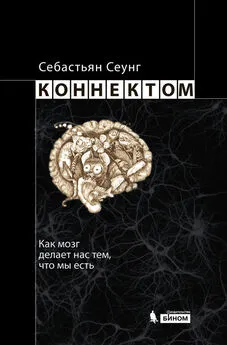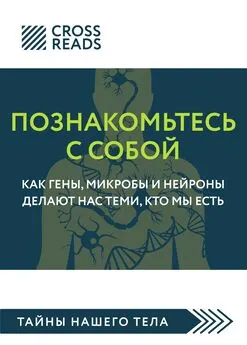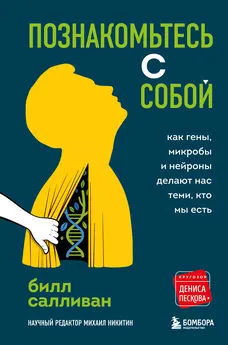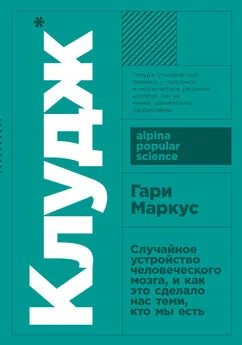Алан Джасанов - Мозг: прошлое и будущее [Что делает нас теми, кто мы есть]
- Название:Мозг: прошлое и будущее [Что делает нас теми, кто мы есть]
- Автор:
- Жанр:
- Издательство:Литагент АСТ
- Год:2019
- Город:Москва
- ISBN:978-5-17-117010-3
- Рейтинг:
- Избранное:Добавить в избранное
-
Отзывы:
-
Ваша оценка:
Алан Джасанов - Мозг: прошлое и будущее [Что делает нас теми, кто мы есть] краткое содержание
Мозг: прошлое и будущее [Что делает нас теми, кто мы есть] - читать онлайн бесплатно ознакомительный отрывок
Интервал:
Закладка:
312
K. Koch et al., «How much the eye tells the brain», «Current Biology» 16 (2006): 1428–1434.
313
B. C. Moore, «Coding of sounds in the auditory system and its relevance to signal processing and coding in cochlear implants», «Otology & Neurotology» 24 (2003): 243–254.
314
R. S. Johansson and A. B. Vallbo, «Tactile sensibility in the human hand: Relative and absolute densities of four types of mechanoreceptive units in glabrous skin», «Journal of Physiology» 286 (1979): 283–300.
315
Daniel L. Schacter, Daniel T. Gilbert, Daniel M. Wegner, and Matthew K. Nock, «Psychology» , 3rd ed. (New York: Worth Publishers, 2014).
316
T. Connelly, A. Savigner, and M. Ma, «Spontaneous and sensory-evoked activity in mouse olfactory sensory neurons with defined odorant receptors», «Journal of Neurophysiology» 110 (2013): 55–62.
317
Eric Griffith, «How Fast Is Your Internet Connection… Really?» «PC Magazine» , 2 июня 2017 года.
318
E. V. Evarts, «Relation of Discharge Frequency to Conduction Velocity in Pyramidal Tract Neurons», «Journal of Neurophysiology» 28 (1965): 216–228; L. Firmin et al., «Axon diameters and conduction velocities in the macaque pyramidal tract», «Journal of Neurophysiology» 112 (2014): 1229–1240.
319
David C. Van Essen, «Organization of Visual Areas in Macaque and Human Cerebral Cortex» // « Visual Neurosciences» , vol. 1, ed. Leo M. Chalupa and John S. Werner. (Cambridge, MA: MIT Press, 2004).
320
N. Naue et al., «Auditory event – related response in visual cortex modulates subsequent visual responses in humans», «Journal of Neuroscience» 31 (2011): 7729–7736; C. Kayser, C. I. Petkov, and N. K. Logothetis, «Multisensory interactions in primate auditory cortex: fMRI and electrophysiology», «Hearing Research» 258 (2009): 80–88.
321
Micah M. Murray and Mark T. Wallace, eds., «The Neural Bases of Multisensory Processes» (Boca Raton, FL: CRC, 2012).
322
M. T. Schmolesky et al., «Signal timing across the macaque visual system», «Journal of Neurophysiology» 79 (1998): 3272–3278.
323
M. E. Raichle et al., «A default mode of brain function», «Proceedings of the National Academy of Sciences» 98 (2001): 676–682.
324
B. Biswal, F. Z. Yetkin, V. M. Haughton, and J. S. Hyde, «Functional connectivity in the motor cortex of resting human brain using echo-planar MRI», «Magnetic Resonance in Medicine» 34 (1995): 537–541.
325
K. R. Van Dijk et al., «Intrinsic functional connectivity as a tool for human connectomics: Theory, properties, and optimization», «Journal of Neurophysiology» 103 (2010): 297–321.
326
V. Betti et al., «Natural scenes viewing alters the dynamics of functional connectivity in the human brain», «Neuron» 79 (2013): 782–797.
327
T. Vanderwal, C. Kelly, J. Eilbott, L. C. Mayes, and F. X. Castellanos, «Inscapes: A movie paradigm to improve compliance in functional magnetic resonance imaging», «NeuroImage» 122 (2015): 222–232.
328
N. Gaab, J. D. Gabrieli, and G. H. Glover, «Resting in peace or noise: Scanner background noise suppresses default-mode network», «Human Brain Mapping» 29 (2008): 858–867.
329
J. H. Kaas, «The evolution of neocortex in primates», «Progress in Brain Research» 195 (2012): 91–102.
330
Камю Альбер. Посторонний / пер. Н. Немчиновой // Камю Альбер. Сочинения. (М.: Прометей, 1989).
331
Matthew H. Bowker, «Meursault and Moral Freedom: The Stranger ’s Unique Challenge to an Enlightenment Ideal», в сб.: Albert Camus’s The Stranger: Critical Essays , ed. Peter Francev (Newcastle upon Tyne, UK: Cambridge Scholars, 2014).
332
A. Vrij, J. van der Steen, and L. Koppelaar, «Aggression of police officers as a function of temperature: An experiment with the fire arms training system», Journal of Community & Applied Social Psychology 4 (1994): 365–370.
333
S. M. Hsiang, M. Burke, and E. Miguel, «Quantifying the influence of climate on human conflict», «Science» 341 (2013): 123567.
334
E. G. Cohn and J. Rotton, «Assault as a function of time and temperature: A moderator-variable time-series analysis», «Journal of Personality and Social Psychology» 72 (1997): 1322–1334.
335
L. Taylor, S. L. Watkins, H. Marshall, B. J. Dascombe, and J. Foster, «The impact of different environmental conditions on cognitive function: A focused review», «Frontiers in Physiology» 6 (2015): 372.
336
G. Greenberg, «The effects of ambient temperature and population density on aggression in two inbred strains of mice, Mus musculus », «Behaviour» 42 (1972): 119–130.
337
Caroline Overy and E. M. Tansey, eds., «The Recent History of Seasonal Affective Disorder (SAD): The Transcript of a Witness Seminar» , Wellcome Witnesses to Contemporary Medicine, vol. 51 (London: Queen Mary, University of London, 2014).
338
N. E. Rosenthal et al., «Seasonal affective disorder: A description of the syndrome and preliminary findings with light therapy», «Archives of General Psychiatry» 41 (1984): 72–80; A. Magnusson, «An overview of epidemiological studies on seasonal affective disorder», «Acta Psychiatrica Scandinavica» 101 (2000): 176–184; K. A. Roecklein and K. J. Rohan, «Seasonal affective disorder: An overview and update», «Psychiatry» 2 (2005): 20–26.
339
G. Pail et al., «Bright-light therapy in the treatment of mood disorders», «Neuropsychobiology» 64 (2011): 152–162.
340
Roecklein and Rohan, «Seasonal affective disorder.»
341
Кандинский В… О духовном в искусстве / пер. Н. Маньковской. (М.: Рипол Классик, 2016).
342
Michael York, «The A to Z of New Age Movements» (Lanham, MD: Scarecrow, 2009).
343
A. J. Pleasonton, «The Influence of the Blue Ray of the Sunlight and of the Blue Colour of the Sky; in Developing Animal and Vegetable Life, in Arresting Disease and in Restoring Health in Acute and Chronic Disorders to Human and Domestic Animals». (Philadelphia: Claxton, Remsen & Haffelfinger, 1876).
344
Adam Alter, «Drunk Tank Pink: And Other Unexpected Forces That Shape How We Think, Feel, and Behave» (New York: Penguin, 2014).
345
A. G. Schauss, «Tranquilizing effect of color reduces aggressive behavior and potential violence», «Orthomolecular Psychiatry» 8 (1979): 218–221.
346
J. E. Gilliam and D. Unruh, «The effects of Baker – Miller pink on biological, physical and cognitive behaviour», «Journal of Orthomolecular Medicine» 3 (1988): 202–206.
347
P. Valdez and A. Mehrabian, «Effects of color on emotions», «Journal of Experimental Psychology: General» 123 (1994): 394–409.
348
A. J. Elliot, M. A. Maier, A. C. Moller, R. Friedman, and J. Meinhardt, «Color and psychological functioning: The effect of red on performance attainment», «Journal of Experimental Psychology: General» 136 (2007): 154–168.
349
R. Mehta and R. J. Zhu, «Blue or red? Exploring the effect of color on cognitive task performances», «Science» 323 (2009): 1226–1229.
350
P. Salamé and A. D. Baddeley, «Disruption of short-term memory by unattended speech: Implications for the structure of working memory», «Journal of Verbal Learning & Verbal Behavior» 21 (1982): 150–164; D. M. Jones and W. J. Macken, «Irrelevant tones produce an irrelevant speech effect: Implications for phonological coding in working memory», «Journal of Experimental Psychology» 19 (1993): 369–381.
351
E. M. Elliott, «The irrelevant-speech effect and children: Theoretical implications of developmental change», «Memory and Cognition» 30 (2002): 478–487.
352
S. Murphy and P. Dalton, «Out of touch? Visual load induces inattentional numbness», «Journal of Experimental Psychology: Human Perception and Performance 42 (2016): 761–765.
353
S. Brodoehl, C. M. Klingner, and O. W. Witte, «Eye closure enhances dark night perceptions», Science Reports 5 (2015): 10515.
354
H. McGurk and J. MacDonald, «Hearing lips and seeing voices», «Nature» 264 (1976): 746–748. Эффект Мак-Гурка был впервые продемонстрирован следующим образом: группе испытуемых одновременно обеспечивали зрительные и слуховые стимулы, а затем спрашивали, что испытуемые восприняли. Можете сами испытать на себе этот эффект: в Сети много соответствующих роликов.
355
M. Corbetta and G. L. Shulman, «Control of goal-directed and stimulus-driven attention in the brain», «Nature Reviews Neuroscience» 3 (2002): 201–215.
356
William James, «The Principles of Psychology» (New York: Henry Holt and Company, 1890).
357
R. J. Krauzlis, A. Bollimunta, F. Arcizet, and L. Wang, «Attention as an effect not a cause», «Trends in Cognitive Science» 18 (2014): 457–464.
358
Corbetta and Shulman, «Control of goal-directed and stimulus-driven attention in the brain».
359
Хэндфорд М… Где Волли? (СПб.: Речь, 2018) и другие книги этой серии.
360
N. P. Bichot, A. F. Rossi, and R. Desimone, «Parallel and serial neural mechanisms for visual search in macaque area V4», «Science» 308 (2005): 529–534.
361
H. F. Credidio, E. N. Teixeira, S. D. Reis, A. A. Moreira, and J. S. Andrade Jr., «Statistical patterns of visual search for hidden objects», «Scientific Reports» 2 (2012): 920.
362
I. Mertens, H. Siegmund, and O. J. Grusser, «Gaze motor asymmetries in the perception of faces during a memory task», «Neuropsychologia» 31 (1993): 989–998.
Читать дальшеИнтервал:
Закладка:
![Обложка книги Алан Джасанов - Мозг: прошлое и будущее [Что делает нас теми, кто мы есть]](/books/1070785/alan-dzhasanov-mozg-proshloe-i-buduchee-chto-delaet.webp)







